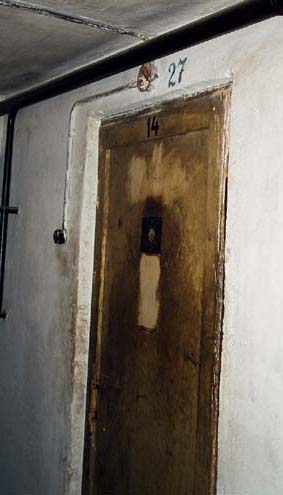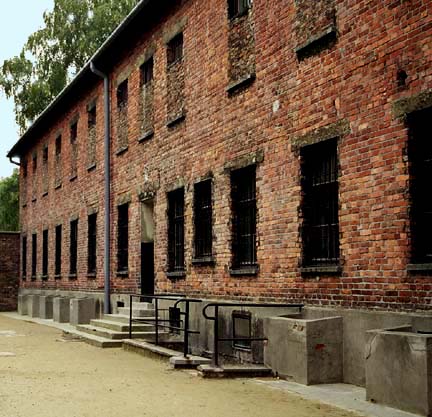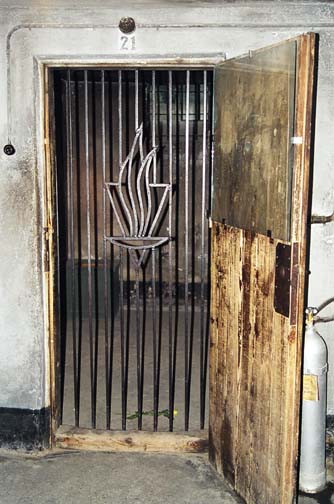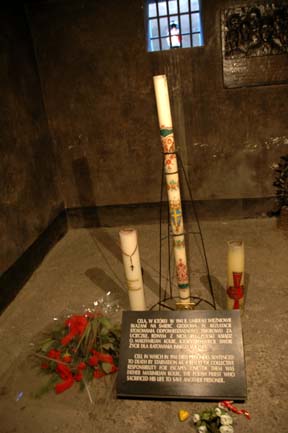Cells Inside Block 11 at Auschwitz
I
 Prison cell #27 where
first gassing of humans with Zyklon-B took place
Prison cell #27 where
first gassing of humans with Zyklon-B took place
In October 1998, I took a tour of the
Auschwitz I camp and saw the inside of Block 11 where there are
prison cells in the basement.
According to my tour guide, on Sept.
3, 1941, the Nazis conducted the first mass killing of people
using Zyklon-B in prison cell number 27 in Block 11. Adolf Eichmann
was visiting the Auschwitz camp on that day, although Commandant
Rudolf Höss was away on business, according to the Auschwitz
Museum guidebook. Since 1939, Adolf Eichmann had been the head of Department
IV, B4 in the Reich Central Security Office (RSHA); Eichmann's
department was in charge of getting rid of the Jews in Europe.
Karl Fritzsch, the camp commander and the deputy of Rudolf Höss,
took it upon himself to carry out this first gassing, while his
superior officer, Rudolf Höss, was away.
The wooden door of the cell where the
gassing took place is shown in the photo above; notice the glass
peephole in the door. Tourists are not permitted to see the interior
of the cell.
The tour guide told me that the room
was sealed by packing dirt into the concrete well around the
window outside; then the prisoners were shoved inside, Zyklon-B
crystals were thrown in through the door, and the door was quickly
shut.
The photo below shows the exterior of
Block 11; concrete wells around the basement windows let in some
light, but prevented the prisoners from looking out. The well
around the window of Cell 27 was filled with dirt in order to
seal the room for the gassing of the prisoners.
 Concrete wells let
in light to basement prison cells
Concrete wells let
in light to basement prison cells
The first tests using Zyklon-B had been
done in August 1941 in one of these basement cells. These experiments
were done long before the "Final Solution of the Jewish
Question" was planned at the Wannsee conference on January
20, 1942. Zyklon-B was, at that time, being used extensively
in the Auschwitz concentration camp, and at most of the other
camps, as an insecticide to kill body lice in clothing in an
effort to prevent typhus epidemics. During World War I, there
were devastating typhus epidemics on the eastern front in what
is now Poland, so the Nazis took special precautions to prevent
epidemics in the crowded concentration camps.
The subjects of this first mass killing
on September 3, 1941 were 600 Russian POWs and 250 sick prisoners.
According to my tour guide, testing done in the previous months
had determined the right amount of Zyklon-B needed to kill a
room full of people. In a book entitled "Anatomy of the
Auschwitz Death Camp," edited by Israel Gutman and Michael
Berenbaum, it was stated that the murder of 600 Soviet Prisoners
of War and about 250 sick prisoners took place in Block 11 between
September 3rd and September 5th. The authors also quoted from
a report by the prisoner underground which said that 600 Soviet
prisoners and 200 Poles were gassed in Block 11 on the night
of September 5th and 6th.
 Starvation cell where
prisoners were left to die
Starvation cell where
prisoners were left to die
Pictured above is prison cell No. 21,
which is similar to the one where the Zyklon-B experiments were
carried out. This cell, and also cell number 27, were called
starvation cells because prisoners, who had been condemned to
death, were kept there without food and water until they died.
This cell has two religious pictures scratched into the wall
by a Polish political prisoner, using only his fingernails. The
wooden door of the cell can be seen on the right; notice the
glass covering the upper half of the door where there are more
scratchings made with fingernails.
 Cell # 18 where Father
Kolbe died
Cell # 18 where Father
Kolbe died
It was in cell No. 18, one of the starvation
cells, that Father Maksymilian Kolbe, a Franciscan friar, was
kept until he was almost dead. According to my tour guide, Father
Kolbe was taken out of his cell after three weeks and given a
more merciful death by an injection to the heart.
Father Kolbe was arrested by the Gestapo
on February 17, 1941 because he had hidden 2,000 Jews in his
friary and because he broadcast reports over the radio condemning
Nazi activities during World War II. On May 25, 1941, he was
sent to the main Auschwitz camp as a political prisoner.
The following quote is from Wikipedia:
In July 1941, a man from Kolbe's barrack
had vanished, prompting SS-Hauptsturmführer Karl Fritsch,
the Lagerführer (i.e., the camp commander), to pick 10 men
from the same barrack to be starved to death in Block 11 (notorious
for torture), in order to deter further escape attempts. (The
man who had disappeared was later found drowned in the camp latrine.)
One of the selected men, Franciszek Gajowniczek, cried out, lamenting
his family, and Kolbe volunteered to take his place.
Gajowniczek was a Polish political prisoner
who had been arrested because he was aiding the Jewish resistance
in Poland, although he was not a Jew himself.
Father Kolbe was canonized a saint in
the Catholic Church on Oct. 10, 1982 in a ceremony held at the
Auschwitz I camp. The cell where Father Kolbe was imprisoned
has been decorated with a commemorative plaque and flowers. Note
the window at the top of the photo; you can see a tourist standing
in the courtyard between Block 10 and Block 11.
This page was last updated on March 6,
2008
|